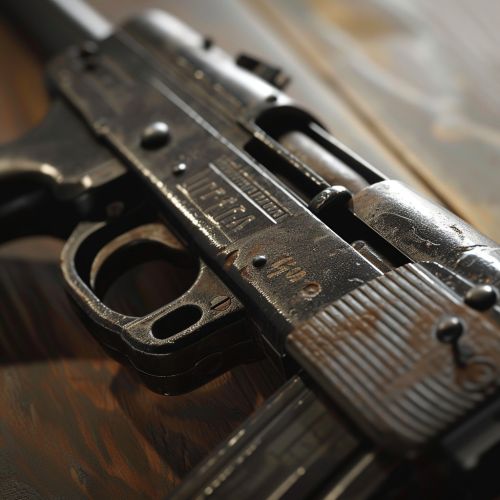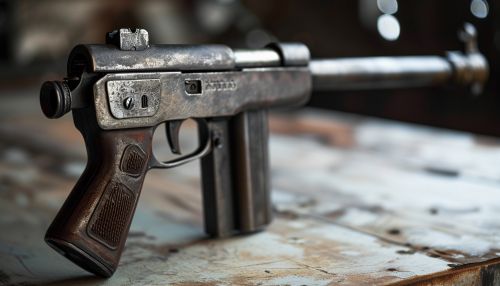MP 40
Development
The MP 40 (Maschinenpistole 40) was a submachine gun chambered for the 9x19mm Parabellum cartridge. It was developed in Nazi Germany and used extensively by the Axis powers during the Second World War. Designed in 1938 by Heinrich Vollmer with inspiration from its predecessor, the MP 38, the MP 40 was often mistakenly called "Schmeisser" by the Allies, despite Hugo Schmeisser's non-involvement in the weapon's design and production.


Design
The MP 40 was a simplified version of the MP 38, with certain features, like machined steel parts, replaced with stamped steel to save on cost and time of production. It was a fully automatic, open-bolt design. The weapon was made up of four main parts: the barrel and receiver group, the bolt, the operating handle, and the return spring. The MP 40's design was quite advanced for its time, and it set the standard for future submachine gun designs.
Operation
The MP 40 operated on the principle of blowback, using the advanced primer ignition (API) blowback method. The bolt was held open by the sear when the weapon was cocked. When the trigger was pulled, the bolt went forward, feeding a round from the magazine into the chamber and firing it. The gas pressure from the ignited cartridge drove the bolt back against the return spring, and the cycle repeated as long as the trigger was held down and there were rounds in the magazine.
Usage
The MP 40 was used extensively by infantrymen (particularly platoon and squad leaders), paratroopers, and other troops during World War II, and was favored for its volume of automatic fire and relatively compact size. It was also used by several other countries during and after the war, and has been seen in many films, television shows, and video games set during the World War II era.
Variants
Several variants of the MP 40 were produced during the war, including the MP 40/I, which featured a dual-magazine holder, and the MP 41, which was a hybrid of the MP 40 and the earlier MP 28. Post-war, the design was copied and produced by several countries, including Spain (as the M41/44), France (as the MAS 38/40), and Yugoslavia (as the M56).
Legacy
The MP 40's influence on firearm design can be seen in many subsequent submachine guns, such as the U.S. M3 "Grease Gun" and the Soviet PPSh-41. Its iconic status has also made it a popular collector's item, and it is often seen in historical reenactments, films, and video games.
